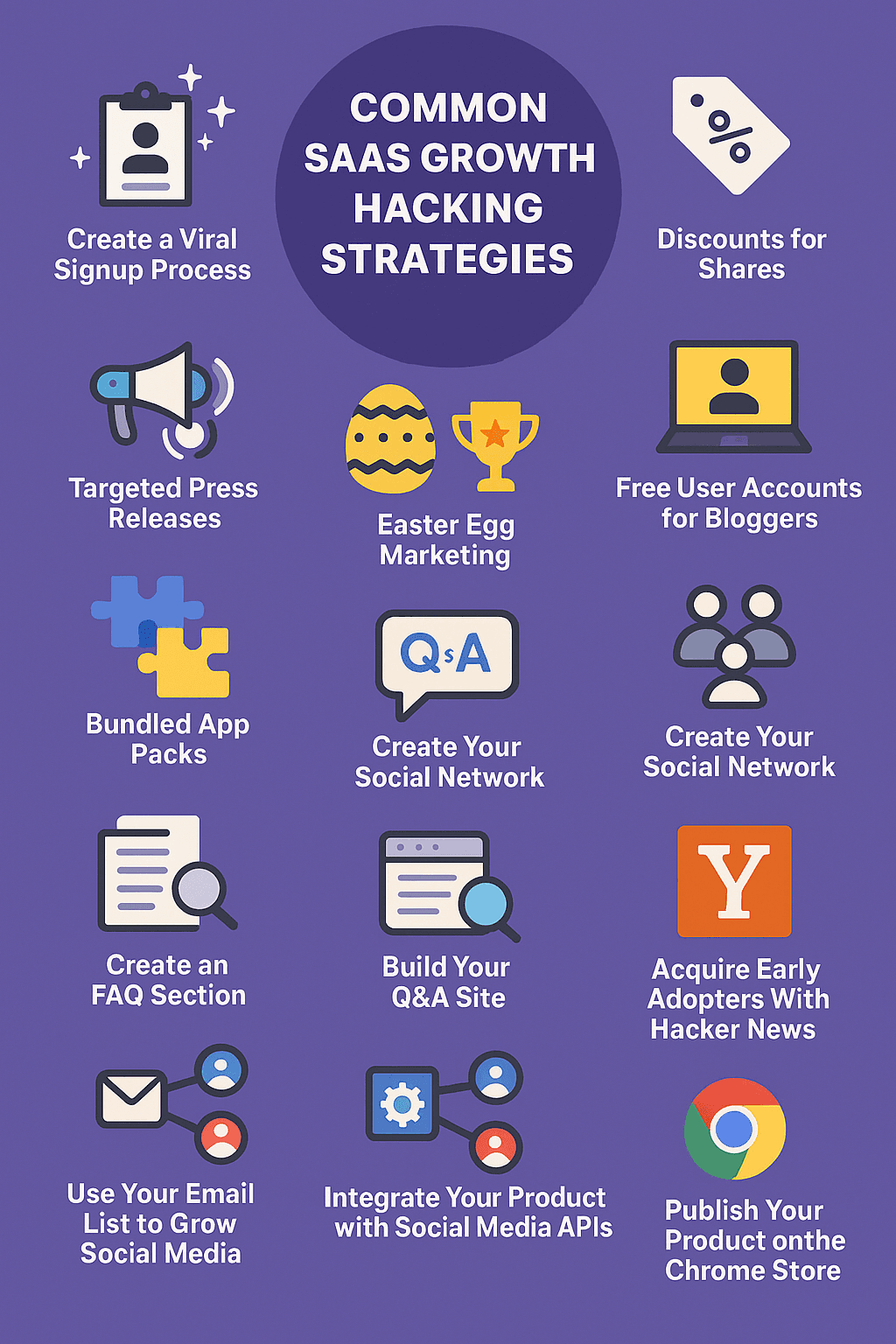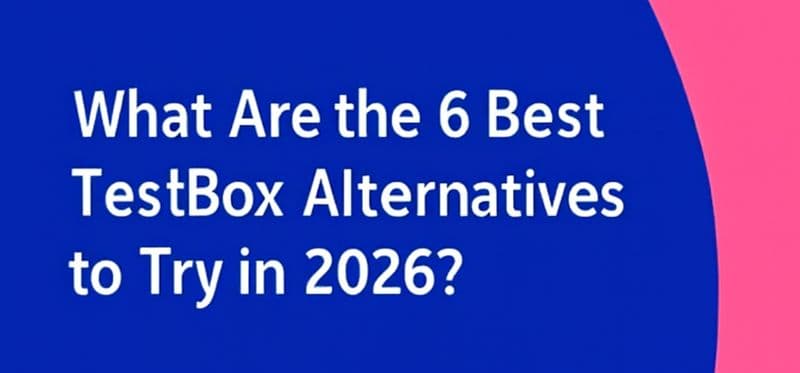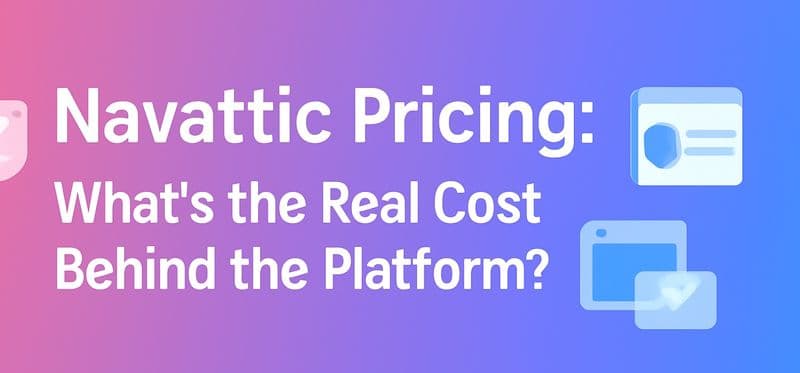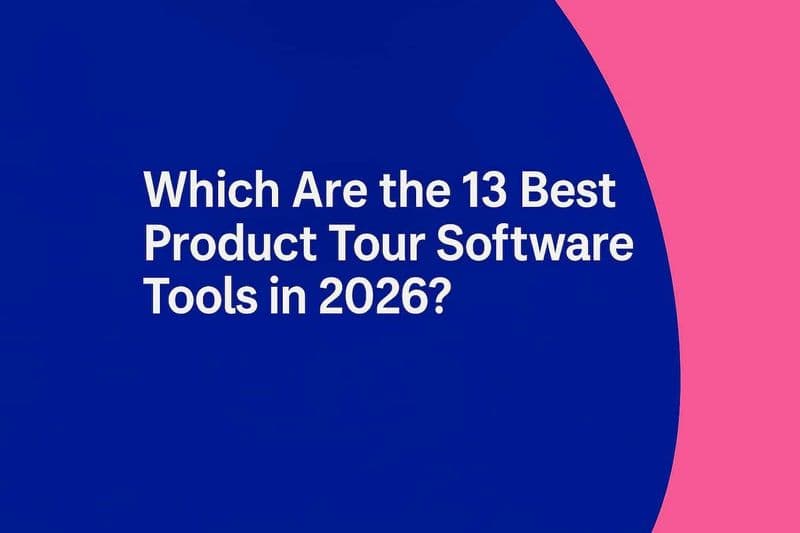
Markets are crowded, ad costs are rising, and users expect instant value. For B2B founders and CTOs, that means you're under pressure to scale fast, without burning through cash or bloating your product roadmap.
This blog is your shortcut.
We’ve curated 15 actionable SaaS growth hacking tips for 2025 that go beyond hype — strategies built to boost user acquisition, improve retention, and drive real revenue. From optimizing your homepage to leveraging browser extensions, content loops, and podcast partnerships, these tactics are designed to work for lean, high-performing teams.
If you're ready to grow faster, convert better, and scale smarter, this is where you start.
What is SaaS Growth Hacking?
SaaS growth hacking is the process of rapidly testing and optimizing creative, low-cost SaaS marketing campaigns to grow a startup's customer base using scalable strategies — from blog posts and content marketing to plugins, retargeting, and even browser-based tools.
It’s not about spammy tricks — it’s about using transparency, data, and smart execution (think Google, Buffer, Salesforce, Dropbox) to turn subscribers into paying users, improve navigation, and reach your target audience through social media sites, ebooks, and tweets.
For modern SaaS marketers, it’s the best way to build traction, validate messaging, and convert interest into revenue — fast.
Detailed Comparison of SaaS Growth Hacking vs. Traditional Marketing
While traditional marketing and growth hacking both aim to increase a company's reach and improve profitability, they differ in approach, expense, and scope. Here, we draw a detailed comparison between the two:
Comparison Parameter | SaaS Growth Hacking | Traditional Marketing |
|---|---|---|
Focus | SaaS Growth hacking primarily focuses on growth, often at the expense of anything else. | Traditional marketing focuses on brand building and general promotion of products or services. |
Scope | Broad scope, aimed at all areas of the customer journey from acquisition to retention | Often limited to specific segments like advertising, public relations, etc. |
Expense | Generally cost-effective as it leverages creativity and uses unconventional strategies | Often expensive, as it includes traditional forms of advertising such as television, print ads, billboards, etc. |
Approach | Experimentation and constant iteration, informed by data, are core approaches. | Usually, a more formal approach based on established strategic plans |
Orientation | Highly customer-oriented, stresses testing products in the market and obtaining feedback | More product-oriented, relies on established needs in the market |
This comparison underscores how SaaS growth hacking provides an innovative, cost-effective alternative to traditional marketing schemes for SaaS companies seeking rapid customer acquisition and exponential growth.
Steal These 15 Proven SaaS Growth Hacking Strategies to Scale Fast in 2025

In B2B, growth doesn't always come from big budgets but from smart moves. Growth hacking is all about testing new, cost-effective strategies to scale and get results quickly. Whether you're aiming to generate leads, retain customers, or outsmart competitors, the right hacks can give you the edge. Let’s dive into some of the most effective B2B growth hacking strategies that can help you grow faster with less.
1) Create a Viral Signup Process
Transforming your signup process into a growth engine is more crucial than ever, especially as SaaS revenue is projected to reach $390.5 billion globally in 2025. It involves transforming your standard signup process into a growth tool by encouraging users to share your platform with their friends. Here’s how it works:
Encourage referrals during the sign-up: During the registration process, instead of just collecting traditional contact information, prompt new users to invite a few friends to also use your app. You're using your new customers to attract even newer ones by creating an incentive for social sharing during registration.
Use social sharing tools: By integrating your signup process with social sharing tools, your users' referral process will become incredibly simple, reducing friction and enhancing the chances of successful referrals.
Constantly monitor referral metrics: Regular tracking of key metrics, like the number of shares or the conversion rate of referred users, can provide valuable insights for making necessary adjustments to optimize the referral program.
Offer incentives: People often need a compelling reason to take action. Offering rewards such as extended free trials, premium features, or discounts can further boost the effectiveness of your viral sign-up strategy.
2) Discounts for Shares
The SaaS market is forecast to grow at a compound annual growth rate (CAGR) of 18.4% from 2024 to 2032 One way to accomplish this is to offer a small discount, 5% or 10%, to users who share your product or landing page on platforms like Twitter, LinkedIn, or Facebook.
Such campaigns can serve a dual purpose: first, they can help grow your social media presence, directly enhancing your brand visibility, and second, they encourage traffic influx to your website, indirectly augmenting user base growth.
Users feel motivated to share your content not just because they're getting a discount but also because they're helping their network save money. This strategy encourages word-of-mouth marketing, which is considered one of the most powerful forms of persuasion.
Remember, the key here is to make sharing easy. With pre-filled text, one-click share buttons can simplify the process for users, thereby improving participation rates and amplifying the campaign's impact.
3) Targeted Press Releases
Despite the digital revolution, traditional press releases still hold substantial power in generating attention and contributing to SaaS growth. By smartly strategizing your outreach, securing coverage in media channels like TechCrunch or VentureBeat could drive your growth.
Here are some guidelines to leverage targeted press releases:
Write a succinct, compelling press release: Keep your press release crisp, compelling, and focused on your brand's story.
Reach out personally: Identify relevant journalists in your business domain and contact them directly.
Follow up consistently: Pursue your leads persistently but politely to ensure your story gets picked.
The targeting approach will depend on the nature of your SaaS product. If it has broad appeal across industries, prioritize popular publications and sites with a wide readership. However, if your SaaS product caters to a certain industry or vertical, aim for websites, blogs, or e-magazines targeting that specific audience.
4) Free User Accounts for Bloggers
As SaaS revenue is expected to account for over 84% of the broader software market, leveraging influential bloggers can help you tap into a user base that increasingly prefers SaaS solutions for flexibility and scalability. Influential bloggers have large followings and hold considerable clout in shaping opinions and trends. Offering them free access to your SaaS product can tap into their vast audience pool, driving traffic and potential customers to your platform.
Here’s how you can set this up:
Identify popular bloggers or influencers within your industry. These individuals should have a considerable social media presence and high platform engagement rates.
Reach out to them with an offer of a free account for your product and request a review in return. This approach works because it provides value to both parties: the influencer can access a potentially helpful service for free, and you benefit from their outreach capability.
Their review offers invaluable third-party validation for your product, further boosting credibility among potential customers. Reviews also serve as user-generated content that boosts SEO rankings, increasing your online visibility.
Remember, the key to success is choosing the right influencers. Their audience should align with your target market and must be known to exert substantial influence on their followers' buying decisions.
5) Easter Egg Marketing
Easter Egg Marketing involves embedding hidden gems, inside jokes, or features within your SaaS product. This tactic adds fun and encourages users to explore and interact more with your product, enhancing user engagement.
Popular brands like Snapchat have successfully used Easter egg marketing. Incorporating hidden features or jokes in your SaaS product instigates discussions and sharing, building a sense of community among users.
However, it is essential to ensure these hidden elements do not confuse or frustrate users. The key is to make them exciting to discover but not integral to the essential use of your product, thus maintaining application usability.
In some instances, rewarded discovery, where users receive a particular benefit or reward upon discovering an Easter egg, can further enhance engagement and motivate users to delve deeper into your software.
Easter Egg Marketing aims to create user experiences that transcend functionality, focusing on the joy of exploration and discovery. This, in turn, fosters a strong connection with your brand.
6) Gamification
The median growth rate for public SaaS companies was 35% as of October 2024. Gamification can help boost engagement and retention, supporting higher growth rates as seen among top-performing SaaS businesses. Gamification is a SaaS growth hacking strategy that involves integrating fun and engaging gaming elements into your SaaS product. This enhances user interaction and motivates them to use your product frequently.
Here's how you can utilize gamification:
Create achievement-based rewards: Encourage app usage by giving users virtual badges or rewards upon completing specific activities or reaching certain milestones within your app.
Design competition features: Incorporate elements of challenge and competition, such as leaderboards or high score tables, which allow users to compare their progress with others.
Integrate social sharing features: Allow users to share their achievements on social media platforms, promoting player engagement and broader visibility for your app.
Offer tutorials through game mode: Train new users on your app's functionalities by incorporating a game-mode tutorial, making learning fun and engaging.
Companies like Duolingo have successfully implemented gamification strategies, turning the mundane task of language learning into an engaging, enjoyable, and rewarding experience. When done right, gamification can increase user engagement and turn users into staunch advocates for your brand.
7) Bundled App Packs
Bundling can be a powerful mechanism to drive growth in the SaaS ecosystem. It involves combining your SaaS product with other complementary products, offering a collective package at an attractive price. This strategy capitalizes on the collective appeal of several products, creating higher perceived value and making the offer irresistible.
This is particularly effective if your SaaS product complements and augments the use of another product. For example, a project management tool could be bundled with a communication tool and a time-tracking app to create a comprehensive productivity suite. By collaborating with businesses offering products complementary to yours, you can reach out to their user base, extending your own in turn.
Bundled packages attract new customers and increase your product's stickiness by integrating it into a broader workflow. With the bonus of cost savings bundled in, customers find such offers hard to resist, aiding in conversion and eventual customer retention.
8) Create Your Social Network
Building an engaged, passionate community around your SaaS product can significantly impact its growth. Increasingly, companies choose to achieve this by creating branded social networks using tools like Spot. IM. This strategy facilitates continuous user engagement, boosts SEO with user-generated content, and offers a direct channel for gathering user feedback.
HubSpot successfully utilized this strategy with its Inbound.org network, creating a space renowned for industry innovation and thought leadership. A social network that embodies your brand values and mission can also serve as a powerful engine for targeted lead generation.
The key to a successful social network lies in its ability to provide value beyond the core functionalities of your SaaS product. Whether through user discussions, expert insights, or direct feedback, the added value encourages users to participate actively, fostering a strong sense of community.
9) Industry-Specific Q&A Sites
Industry-specific Q&A sites can serve as potent platforms for SaaS growth. Answering questions and providing valuable insights on forums like Quora, Reddit, StackOverflow, or GrowthHackers.com can boost your brand visibility and establish your thought leadership in the industry.
When used judiciously, these platforms can be powerful tools for SaaS SEO. A practical method is to engage with potential customers through discussions, raising awareness about your product while driving targeted traffic back to your website.
Contributing helpful, actionable answers can elevate your brand reputation and foster trust with potential customers. This strategy and maintaining regular, quality interactions can ultimately lead to enhanced user acquisition and growth. However, remember that the goal here isn't just to promote your product and provide genuine value to the community. Authentic, helpful interactions will pique interest in your product and foster a positive brand image.
10) Create an FAQ Section
Building an FAQ (Frequently Asked Questions) section into your website is a simple yet effective SaaS growth hacking tips to leverage customer inquiries for business growth. It is a repository of valuable information based on recurring customer queries, enabling users to resolve common issues swiftly.
A well-crafted FAQ page offers numerous benefits:
Boosts SEO: Each FAQ provides an additional contextually rich page to index, potentially enhancing your search engine rankings.
Frees up customer support time: A comprehensive FAQ page can resolve many recurring customer queries, reducing the burden on your customer service team.
Improves customer experience: An FAQ section enhances user experience on your website by providing instant answers to common queries.
11) Build Your Q&A Site
Being active on popular Q&A sites is fruitful, but building your Q&A site takes this strategy up a notch. Creating your Q&A platform allows you to moderate discussions and control the narrative around topics related to your business, besides generating valuable SEO-friendly content.
Strategies to get started include:
SEO Optimization: Make your site as search-engine-friendly as possible for enhanced visibility.
Utilization of other Q&A platforms: Leverage existing Q&A sites in your niche to promote your new platform.
Incentivize User Contributions: Encourage users to contribute quality content by offering rewards and increased recognition.
The Chrome Extension Store is a goldmine for SaaS growth. Publishing your product in your browser can unlock massive visibility and user acquisition.
12) Acquire Early Adopters With Hacker News
Hacker News is a goldmine for attracting early adopters and gathering honest feedback.
Post a simple review request, engage openly, and listen closely. The tech-savvy community offers sharp insights that help refine your product and generate early buzz.
Their feedback shapes your roadmap, and their support can drive real traction through shares and word-of-mouth.
13) Use Your Email List to Grow Social Media
Your email list is more than just contacts—it’s a gateway to growing your social presence.
Export your list, use tools like HubSpot or FullContact to find linked social accounts, and connect via platforms like Twitter (ManageFlitter) or Facebook (custom ads).
This boosts your social following while keeping your email audience engaged across channels. More visibility, more engagement—win-win!
14) Integrate Your Product with Social Media APIs
Integrating your SaaS product with social media APIs is a smart way to boost visibility and engagement. It lets users easily share updates, referral links, and achievements—amplifying your reach organically.
Growth in the SaaS world isn't about playing it safe—it’s about bright, bold moves. With the right hacks, you can turn market shifts into opportunities, boost visibility, and drive actual results, especially by experimenting with different pricing tiers. Just remember: test, tweak, and tailor every strategy to fit your unique audience. That’s where actual growth begins.
In short, social media integration is a powerful growth lever for any SaaS looking to scale fast.
15) Publish Your Product on the Chrome Store
The Chrome Extension Store is a goldmine for SaaS growth. Publishing your product there can unlock massive visibility and user acquisition.
Here’s how to make it count:
Design a standout icon – Visuals matter. A sleek, eye-catching icon helps you rise above the noise.
Write a sharp description – Highlight key benefits clearly and concisely to hook users fast.
Categorize wisely – Smart tagging improves discoverability.
Push for reviews – Ratings and social shares build trust and boost visibility.
Key metrics, such as user acquisition rates, cost per acquisition, customer lifetime value, conversion rates, retention rates, customer churn rates, monthly recurring revenue, and overall engagement metrics like active users or session duration, can measure the success of SaaS growth hacks.
Ready to Grow Your SaaS Company Smarter? Try SmartCue
If you’re struggling to convert prospects into paying users, the problem might not be your product — it’s how you’re showing it.
That’s where SmartCue comes in.
SmartCue helps SaaS marketers and sales teams create interactive, personalized product demos without any code or dev time. Whether you're driving signups through blog posts, launching outbound campaigns, or supporting your SDR team, SmartCue lets you deliver the right story to the right user at the right time.
How SmartCue Helps You Turn More Prospects into Customers
1. Create Personalized Demos in Minutes
No need to wait for engineering. Use SmartCue’s intuitive dashboard to build a product walkthrough using your existing app interface. Highlight key features, guide users with cues, and customize content per persona or use case.
2. Embed Demos Anywhere
Add interactive demos to landing pages, blog posts, or even paid campaigns — so your users experience product value before signing up.
3. Equip Your Sales Team
Arm SDRs and AEs with ready-to-go demo flows that match specific customer needs. They can send a demo link post-call or use it live during a screen share — perfect for product-led sales.
4. Track Engagement in Real Time
SmartCue gives you detailed analytics on how users interact with your demos, so you know what’s working and where they drop off. Use these insights to improve messaging and conversion paths.
5. Scale Product Marketing Without Dev Bandwidth
Launch campaigns, test messaging, and iterate fast — without pulling engineers off your core roadmap.
SmartCue is more than a demo tool — it's a growth engine for modern SaaS teams.
Ready to showcase your product the way it deserves? Start your free trial for 14 days today.
Conclusion
Growth in the SaaS world isn't about playing it safe—it’s about bright, bold moves. With the right SaaS growth hacking tips, you can turn market shifts into opportunities, boost visibility, and drive actual results. Just remember: test, tweak, and tailor every strategy to fit your unique audience. That’s where actual growth begins.
Frequently Asked Questions
How can small SaaS companies compete with major players using growth hacks?
Small SaaS companies can utilize Saas growth hacking techniques, such as creating a disruptive signup process, establishing robust social networks, offering bundled app packs, integrating their products with social media APIs, and publishing their products on the Chrome Store, to compete effectively with major players.
What metrics are crucial for measuring the success of SaaS growth hacks?
Key metrics, such as user acquisition rates, cost per acquisition, customer lifetime value, conversion rates, retention rates, customer churn rates, and overall engagement metrics like active users or session duration, can measure the success of SaaS growth hacks.
How often should SaaS companies revise their growth strategies?
SaaS companies should strive to iterate and refine their growth strategies continuously. Ideally, growth strategies should be reviewed quarterly for effectiveness based on key performance indicators and adjusted according to changing market trends and customer feedback to maximize growth potential.
What are the most effective SaaS growth hacks for 2025?
The most effective SaaS growth hacks for 2025 would involve creating a viral signup process, leveraging targeted press releases, offering free accounts to influential bloggers, utilizing Easter Egg marketing strategies, and integrating your product with popular social media APIs to gain broader visibility and user engagement.
What role does customer feedback play in SaaS growth?
Customer feedback is crucial in shaping the growth trajectory of SaaS companies. It provides valuable insights into user preferences and pain points, helps refine product features, and enhances customer service responsiveness. Ultimately, responding effectively to feedback fosters customer loyalty and drives SaaS growth.


